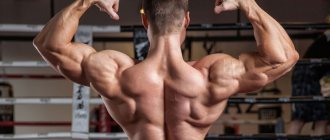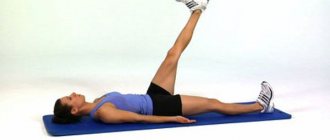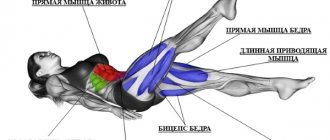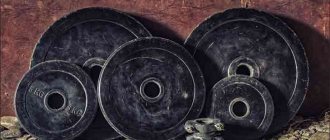Benefits and disadvantages of pull-ups behind your back
Any pull-up involves the latissimus dorsi, but pull-ups behind the head, due to the change in body position and greater amplitude when moving upward, distribute the load on the rhomboid and teres muscles, which creates proportionately massive muscles and promotes broadening of the back.
Thanks to the pronounced (compared to other pull-up options) static load and pause at the top point of the amplitude, the target muscles acquire clearer outlines and relief.
You can't do without minuses.
- This exercise is not suitable for those athletes who have individual anatomical characteristics of the body.
- Also, you should adhere to the technique of performing the exercise, if you ignore it, the effect of the exercise will be minimal.
Features of the load and its effect on muscles
Which muscles are actively pumped during pull-ups, and which are indirectly involved, depends on the chosen method of performing the exercise and the width of the grip. Using different techniques, you can work on problem areas and form an ideal, proportional body. We invite you to study the most popular exercises with photos. Most often, athletes perform pull-ups:
Straight wide grip. A complex exercise that allows you to work the trapezius and latissimus dorsi muscles. Suitable for experienced athletes. You need to spread your arms as wide as possible (there should be 70-100 cm between your palms) and grab the horizontal bar with them. Your thumbs should be on top of the bar. Feet together. We move smoothly and strictly in a vertical plane.
Narrow grip. Pull-ups with a narrow straight grip mean that the athlete has placed his arms narrower than the line of the shoulders. An overhand grip means that the palms are turned away from the athlete. During pull-ups, the shoulders, serratus anterior and latissimus dorsi muscles, and biceps work the most.
Reverse medium grip (variations - wide and narrow). When performing, the main load falls on the biceps and latissimus dorsi muscles. An excellent solution for beginners. Hands are shoulder-width apart; you need to grab the bar so that your fingers are turned towards you. When raising your body above the level of the horizontal bar, you must ensure that your shoulders are pulled back as far as possible.
Parallel (neutral) grip. Perform the exercise on two parallel bars. You need to grab them, bend your legs at the knees and cross them. During training, the lower sections of the latissimus dorsi muscle develop, as well as the muscles of the shoulders and biceps.
Horizontal or, as they are also called, Australian pull-ups. They are performed on a low crossbar. It is necessary to take the starting position. To do this, grab the bar with a medium grip. The heels rest on the floor. The athlete hangs on outstretched arms, and then performs flexion and extension of the arms at the elbow joints. During the exercise, the body is tense and extended in a straight line.
A more complicated version is pull-ups by the head or with one arm. When pulling up behind your head, you will be able to pump up your back, namely the rhomboids, latissimus and teres major muscles. Additionally, the biceps and chest are included in the work.
Starting position – hanging with a wide grip on the horizontal bar. As you exhale, we pull the body up, but do not reach for the bar with our chest, but move our head forward so that the horizontal bar is at the level of the back of the head.
Now a few words about one-arm pull-ups. There are two techniques - with a grip towards yourself and away from you. The work involves the muscles of the back and forearm, and biceps. The auxiliary load falls on the deltas. To do pull-ups, you need to grab the horizontal bar with one hand; you can clasp your wrist with your other palm, then it will be easier. Perform the same number of repetitions for each limb.
Now you know which muscles are used during pull-ups and how to pump them up. If you found the article interesting and useful, tell your friends about it. To do this, just share the information on your social media page. networks. We thank everyone in advance. See you again, friends!
(No ratings yet)
What muscles work in pull-ups?
- The main load falls on the latissimus, round and rhomboid muscles of the back.
- Also involved are the trapezius muscles, posterior deltoids, biceps, forearms and serratus muscles.
- The stabilizers during the movement will be the spinal extensors and abdominal muscles.
Execution technique
Not only the effectiveness of pull-ups, but also the safety of the athlete depends on the execution technique. The exercise is performed as follows:
- Starting position – hanging on the crossbar. The grip should be wide, slightly wider than shoulder width. First you need to hang on the horizontal bar with relaxed arms. The tension should only be felt in the forearm. A deep breath is taken.
- Pull-ups are performed while exhaling. The highest point of lifting is the middle of the back of the head. In this case, you should not press your elbows to your body. Otherwise, the amplitude will decrease and the effectiveness of the exercise will decrease.
- You need to lower as smoothly as possible, inhaling. At the end, the starting position is assumed.
More experienced athletes can pause at the top for an extra inhale and lower as they exhale. However, this option is not for everyone.
Technique for performing pull-ups with a wide grip behind the head
This is a difficult exercise. It’s easy to do, but getting the desired effect from head pull-ups is actually not easy. This is because the exercise is based on a specific movement and requires concentration, stretching and experience from the athlete to perform it. Otherwise, only the biceps will work.
The starting position is the same as for regular pull-ups. Consider a wide grip:
- The athlete should grab the bar with a wide grip - hands should be wider than shoulder-width apart.
- The head should be moved slightly forward. This will allow you to straighten your back as much as possible. There is no need to throw your head back or tilt your head too much.
- While exhaling, pull yourself up with the back of your head behind the bar. During this movement you need to bring your shoulder blades together. At the top point of the amplitude, the shoulder blades should be completely retracted. The trapezoid should be kept static.
- The peak point of amplitude will be reached when the shoulder blades close completely, and a distance of a couple of centimeters remains from the crossbar to the back of the head.
- When you reach the top point, you should pause and slowly lower down.
- At the bottom point, you should straighten up completely, allow the latissimus dorsi muscles to stretch properly and repeat the movement.
Load on individual muscles
During pull-ups with additional weight, the load on the muscles depends on the method of placing the hands. What does it mean?
Placing your hands with a narrow front grip perfectly develops your biceps and forearms. Of course, the back also participates in the movement, but the arms undoubtedly take the entire load. This method is good because due to the setting, the amplitude of movement increases significantly, that is, the body receives more load.
Placing your hands with a narrow reverse grip allows you to receive more stress on your back. Supination makes it possible to stretch the latissimus dorsi muscles, and high amplitude provides the most functional load. The downside of this setup is that the biceps quickly become clogged.
A wide straight grip is the most effective method to give an excellent load on the back muscles. During the upward movement, muscle contraction is at a high level, which perfectly works the back. The downside is that the amplitude is much lower, so the stretchability is worse.
Correct technique
- Jump up and grab the bar wide. Usually, a distance between the palms of 20-25 centimeters wider than the shoulders is sufficient.
- Hang on the bar, straightening your arms and relaxing them - only your forearms are tense. Your palms are just a hook on which you hang.
- Take a deep breath, hold your breath, while holding it, tighten your lats and stretch upward. The elbows remain in place; there is no need to pull them to the sides.
- Pull yourself up to the top point: either when your chin is above the bar or at the same level with it, if you are doing pull-ups to your chest, or when the middle of the back of your head is at the level of the bar, if you are doing it behind your head.
- Exhale and slowly lower yourself down.
What mistakes do people often make when performing such exercises?
When a person pumps his back muscles, he can harm his body. How:
- Grip width that does not correspond to the athlete’s capabilities.
- Bending the body at the top. In order for the upper back muscles to be loaded, your shoulder blades must be squeezed together the entire time you do the exercise. The head should stand strictly straight. If you used your muscles during the lift, then you will really want to relax and bend over the top. We do not recommend using this method.
- Active load on the biceps. If you want your biceps to get bigger, you need to use a reverse close grip. If you resort to using a wide grip, then your back will be primarily worked. To make your back wider and stronger, you don’t need to pump up your biceps. In this case, your hands should simply hold your body, but not help your back.
- The connection of the elbows is closer to the body. The amplitude is reduced, so you just start doing useless exercises.
- Connecting the chin to the chest while pulling up behind the head with a wide grip.
- Quick descent. In order not to harm yourself, you should try to lower yourself slowly, without using sudden movements. In this case, the shoulders will not receive a serious load, and the muscles will receive the load necessary for hypertrophy.
- Not working at full capacity. You need to lower yourself all the way so that your arms are straight and not bent at the elbows. You should rise up to the crossbar at the chin or the middle of the back of the head.
How many times should you do the exercise
Most often, pull-ups of this kind are performed during the day not by beginners, but by athletes who are already quite experienced in this area. 3-4 approaches of 10-15 times will be enough to get a payload, but not overwork.
Thus, if you follow the tips described above, then you will be able to do the exercise correctly and will not harm your health.
We also recommend that you familiarize yourself with the back pull-up exercise. It is very similar to this, only pull-ups are performed not behind the back, but to the chest. Be sure to read it if you want to have a big and pumped up back!










